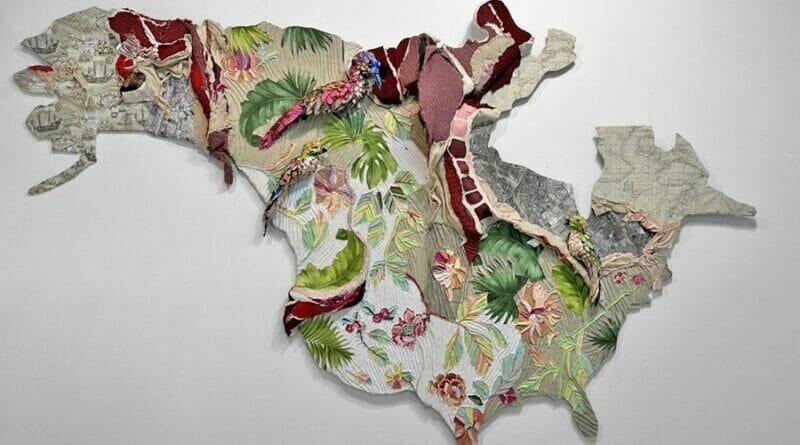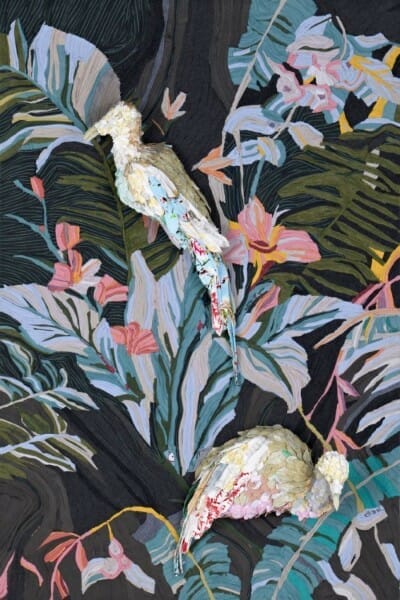TAMARA KOSTIANOVSKY – TROPICAL ABATTOIR
02/09/2023 – 07/10/2023
RX | Paris 16 rue des Quatre Fils – 75003 Paris
T : +33 (0)1 71 19 47 58
Horaires : mardi – vendredi, 10h-13h/14h-18h, samedi 11h/19h
E : info@galerierx.com – W : www.galerierx.com
For her second solo exhibition at Galerie RX Paris, Tamara Kostianovsky presents a dozen works created exclusively for this “tropical slaughterhouse.” The themes dear to her are violence, colonization, overconsumption and the environment. Alongside the animal carcasses that have made her famous, she presents a new series of three murals that she describes as “carnal geographies.” Her works read like oxymorons, combining beauty and cruelty, subtlety and brutality, classicism and baroque.
We move among imposing suspended animal carcasses, navigate within geographical maps that combine bits of flesh, birds and exotic vegetation, marvel at fragments of landscapes where colorful birds sing… Tamara Kostianovsky transforms the RX gallery into a “tropical slaughterhouse” and draws us into her fascinating, raw and evocative universe. Both through her works and through the title of the exhibition, she creates tension and keeps us on our toes with her delightful use of oxymoron. Like a tightrope walker, he walks on a ridge, striking a subtle balance between beauty and horror, refinement and brutality, renewal and decay, life and death. There is nothing innocent about his work, and behind the invasive decorative motifs à la Matisse, the artist makes a clear and unequivocal statement. He tells us about violence, colonization, overconsumption and the environment, always with relevance. “The series represents carcasses that are transformed into vegetation, becoming capsules that house exotic birds and plants. I think of these works in terms of metamorphosis. The idea is to change the image of the carcass from a place of carnage to a matrix where life takes root, like a utopian environment.” To achieve this goal, the artist creates his sculptures from clothing (one of the most polluting industries), his own or from other sources, as well as from upholstery fabrics. He assembles them, sews them, overlaps layers, brings flesh to life and makes color shine. We are seduced.
Intimate violence
His works are heartbreaking, both literally and figuratively, as his carcasses give us a glimpse of the inside of these shredded animals. Art history flows before us, from Rembrandt’s Skinned Ox to Artur Barrio, Adriana Varejao, Luis Jiménez, Goya, and the Latin American Baroque. She glimpses in them the violence of intensive cattle ranching in Argentina, but also the sutures of cosmetic surgeries performed by her father, whom she knew well because she worked for a time in his studio, and the symbolism of Christ’s sacrifice, an iconography ubiquitous in her references despite growing up in a Jewish family. Tamara Kostianovsky knows some cruelty in spite of herself, starting with that of the military dictatorship in Argentina (1976-1983), where so many opponents disappeared in the ATACAMA desert, and more intimately with the savage murder in 2004 of her grandmother, a Holocaust survivor. This episode is even more abominable because it remains unexplained and unpunished.
The migration experience
Her maps and decorative panels address the theme of migrations, not only those that have marked history, but also those of her family (which left Europe in the 1950s) and her own: born in Jerusalem in 1974, she grew up in Buenos Aires until 2000, when she moved to the United States. She focuses on major colonized continents (Africa, North America and South America) and appropriates maps that have always had a political dimension: the contours of the world are drawn to know it, divide it, share it and control its populations and wealth. His geographies become carnal.
His decorative panels also approach the theme of colonization from another point of view. The artist researched 18th-century French wallpapers that depicted idealized and imaginative visions of colonies, which gave rise to Orientalism. The artist interprets the motifs of lush vegetation and feathered birds while recalling the cruelty of the Spanish conquistadors, who went so far as to “set fire to the aviary of Moctezuma II (1502-1520), the last great Aztec emperor,” she explains.
Tamara Kostianovky’s works have a cathartic dimension and convey trauma into creative energy.



